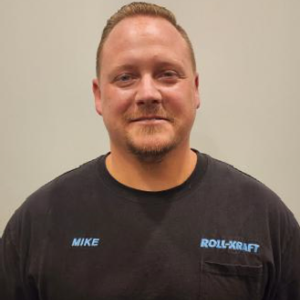Subscribe To Roll-Kraft
Receive the latest news from Roll-Kraft.

By: Bret Molnar, Senior Technical Performance Specialist
The “normal” and easy range of a T/D ratio is between 3% and 8% for any style of breakdown design.
As an example of this for a 2.500” OD tube would be a gauge thicknesses range would be between .075” to .200”. Once the lower end of less than 2% (.050” for 2.500” OD), it becomes more difficult to form especially on higher strength materials. The most typical problem on the light gauges 2% and under is edge buckling: pronounced edges are needed to support the tube.
Edge Buckling on lighter walls
On the heavy side of the range, more issues are apparent when there is a 12.5% T/D. For a 2.500” OD tube, this would equate to .313” thick material. Typical issues with heavy gauge include edge damage from the strip entering the first pass and flat spots that can be carried all the way through the mill.
Flat spots on edges
Roll-Kraft has worked with ranges of .7% up to 24% depending on the starting tube size, so working outside the “normal” range is done fairly often. In each direction, up or down, (heavy or light) present their own issues and Roll-Kraft has solutions to them.
Roll-Kraft has worked with 2.500” OD x .020” thick material, which is a .8% T/D ratio. This can be very difficult and you must have the right conditions and mill configuration to be able to form this light of a T/D ratio. The incoming strip slit quality will play a very important part in how well the tube will form, as any excessive camber or uneven/excessive burr will affect the forming process.
To form this light of a gauge, either a “W” style design or a versatile edge form design is needed to form up properly without buckling. These issues start to be experienced at about a 1.5% T/D ratio (.038” gauge) on a 2.500” OD tube.
For some materials, the “W” style design is used in combination with a versatile edge form design to control the very light gauges. The gauge match between the top and bottom breakdown rolls becomes very critical, as you must impress the correct radius into the strip edges. If this is not done, there will be flat spots left which will not be able to be worked out later and can cause a greater chance for buckling. Once the strip leaves the male/female “hit” that the breakdowns provide cannot be formed later in the open air forming of a cage system, cluster of side rolls, or, as stated before, in the fin section.
Many times in the light gauge forming applications, any bearing resistance from one side roll to another or one weld roll to another can cause a buckle. Sealed bearings installed in side pass or weld box tooling must have a sleeve between the inner race to prevent bearing lockup/drag when the rolls/bearings are assembled and tightened up. The drag/resistance must be equal from one side to the other. Any rolls out of parallel or having misalignment can cause a buckle.
Downhill forming can greatly improve the success of forming the light T/D ratio’s by balancing the increase in strip stretch between the body of the tube and the edges. Driven roll throat progression keeps the strip taught between stands and having different drives between sections improves the chances of success.
Some applications have gone to a “pull through” mill configuration to increase their chances of forming the extreme light gauges. Horizontal spacing of the driven and side passes can influence how well a lighter strip will form. It needs to be better supported between stands as it lacks column strength, especially on the smaller size tubes.
Funnel forming using cages or nylon blocks have been used to assist in light gauge forming. The mill horizontal spacing is critical, as the tube must be supported and not be allowed to relax and cause even more edge stretch between stations.
Heavy T/D ratios present their own forming issues. 10% to 15% ratios are fairly common. The highest Roll-Kraft has worked with is 24%. The thicker strip requires a lot of forming pressure to make it bend on the edges and take a set. The mill must be stout enough through adequate driven shaft size and a narrow a roll space to prevent shaft flexing.
The issues can start right in the first pass with the edges being damaged just by entering the rolls. The amount of pressure needed creates a pivot point between the start of the edgeform against the strip edge and the roll and will cause a bevel or protrusion from the strips edge (see picture).
Heavy Gauge Edge Damage
These edge conditions can affect weld integitity if not addressed. This condition can be reduced by a relaxed amount of work in the first station. It is not possible to eliminate it entirely and take away from the required pressure to properly form the edges of the strip. The pressure needed to bend the strip can cause the shafts to flex and go out of parallel very easily if not adjusted properly. Then stability becomes the issue. The mill must be in good condition and care must be taken that all passes are forming equally as designed. The inboard stand to outboard stand must be maintained parallel. It is very important to maintain the overall integrity and alignment of the entire mill line.
The assumption at this stage is that the integrity and the alignment of the mill are good. (If not, please our resource center for information on maintaining your mill).
As outlined with the light gauge material, as much work as possible must be done when the strip is in the male/female “hits” of the breakdowns. If you try to air form the heavier gauges in a cage or cluster side passes, it will be very difficult to maintain equal pressures side to side and keep the strip stable, rolling over and side to side. This is especially true on smaller tube and pipe.
The fin passes after the breakdowns will have more work to do, forcing the strip to try to take a shape before welding and will wear much faster than with lighter gauges. The strip will try to force the two containment halves of the top fin pass rolls to spread apart resulting in chipping of the inside edges of the rolls. (See illustration below) Again, it is very important to maintain the stand integrity and keep the roll space tight.
Visit our resource center for more valuable technical support articles and videos. Contact our sales/engineering staff if you have a certain tube size/gauge that needs evaluating for possible changes in design as outlined above.
Packaged for Performance
We take your investment seriously. Every step we take is designed to protect it. Tooling shows up in 100% prime condition, ready to perform. Guaranteed.
Learn more about our Performance Guarantee and latest results.
Simply contact us here or call and get answers 24/7.
Contact Us (888) 953-9400
Roll-Kraft is pleased to announce the appointment of Mr. Mike Samplak to the position of Plant Manager at its headquarters facility in Mentor, OH.

Roll-Kraft is pleased to announce the appointment of Frank Lowery to Vice President of Roll Form Applications.

Roll-Kraft is pleased to announce the appointment of Kevin Gehrisch to the position of President.